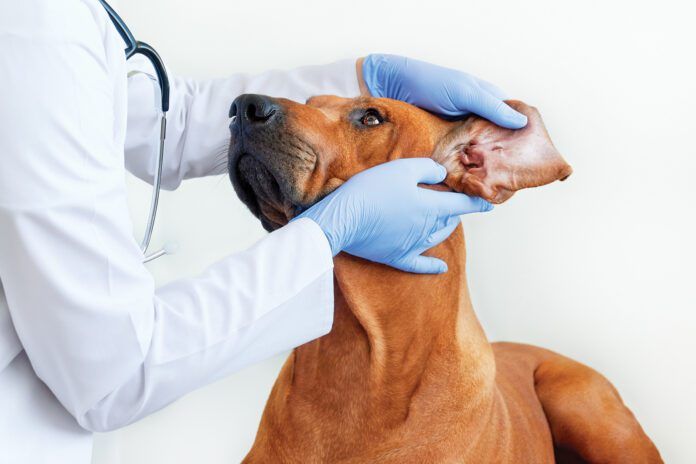Are itchy, stinky ears interfering with your dog’s daily dose of fun? A quick internet search might lead you to ear mites in dogs as the culprit.
Otodectes cynotis is an ear mite that infects the ear canals of dogs, cats, rabbits, and ferrets. Although this species of ear mite prefers these three species of mammals, any mammalian species will satisfy its needs for survival. It survives by ingesting the dead skin cells and ceruminous exudate (ear wax) that line the ear canals.
Symptoms of Ear Mites in Dogs

Ear mites in dogs cause an inflammatory reaction in their ear canals. This is what causes your dog to scratch at his ears and shake his head. It also leads to symptoms including:
- Ear Discharge: The ceruminous glands that line your dog’s ear canals ramp up the production of ear wax to drive out the ear mites. That smelly, dark brown, crumbly discharge in your dog’s ears is a combination of ear wax, ear mites, and their excrement. It often resembles the color and texture of coffee grounds.
- Ear Infections: Dogs who have ear mites will often develop a secondary bacterial and/or yeast infection in their ears. This can change the color and texture of the ear discharge from crumbly brown to creamy yellow or green. Sometimes the discharge may be mixed with blood if your dog scratches his ears so hard that they bleed.
- Skin Redness, Bald Spots, and Itching: If it becomes too crowded inside your dog’s ears, then some of the mites will leave the ear canals to find more spacious living quarters. Ear mites can live on the skin surface outside of your dog’s ears, snacking on skin oils and dead skin cells. They can be found crawling on the skin around the ears and on the neck and face. When your dog curls up in a ball to sleep, the mites can crawl out of the ears onto the skin of the rear end or tail. Mites will cause itchiness wherever they reside, so dogs with ear mites may scratch and develop skin redness and bald spots in areas besides their ears.
The only way to accurately diagnose an ear mite infestation is to examine a sample of your dog’s ear discharge under a microscope. The average length of an ear mite is only three-tenths of a millimeter. While this is too small to be seen by most people’s unaided eyes, ear mites can be easily spotted under a low-power microscope lens.
How to Treat Ear Mites in Dogs
There are several . Typically, the veterinarian will thoroughly clean the dog’s ears and prescribe ear drops or ointment, especially if the dog has secondary bacterial or yeast infections in the ear. A topical medication—usually a flea or heartworm preventative—may also be recommended.
The only dogs who should receive treatment for ear mites are ones who have been diagnosed with ear mites or who live in a home with a pet who has been diagnosed with ear mites.
It is important to know what you are treating before you treat. Ear infections caused by bacteria, yeast, or a combination of bacteria and yeast can look similar to ear mite infestations. Using the incorrect treatment can worsen the underlying problem, cause more pain for your dog, and may lead to hearing loss or deafness. If your dog is scratching at his ears, shaking his head, and having discharge from his ears, have your dog examined by a veterinarian as soon as possible to determine the best course of treatment.
What Causes Ear Mites in Dogs?
Ear mites spend their entire life cycle on one or more host animals. Ear mites can live for a few days in the environment but cannot survive without being on a host animal.
Ear mites spread by crawling between animals. They cannot hop or jump. To become infested with ear mites, a dog must have direct contact either with another animal who has ear mites or the gunk that recently came out of an infected animal’s ears.
How to Prevent Ear Mites in Dogs
Regular use of a flea or heartworm preventative that contains an ingredient shown to be effective against ear mites, such as Revolution, Advantage Multi, Interceptor, Nexgard, Bravecto, or Simparica can help prevent ear mites in dogs.
If there are cats in the home who venture outside, regularly use a flea preventative on those cats that contains an ingredient shown to be effective against ear mites, such as Revolution, Advantage Multi, or Bravecto.
If there are ferrets in the home who venture outside on a harness and leash or rabbits in the home who spend time outdoors in a hutch or pen, talk to your veterinarian about applying Revolution monthly to these pets. This is an off-label use of Revolution in these species and must be prescribed and dosed correctly by your veterinarian.





